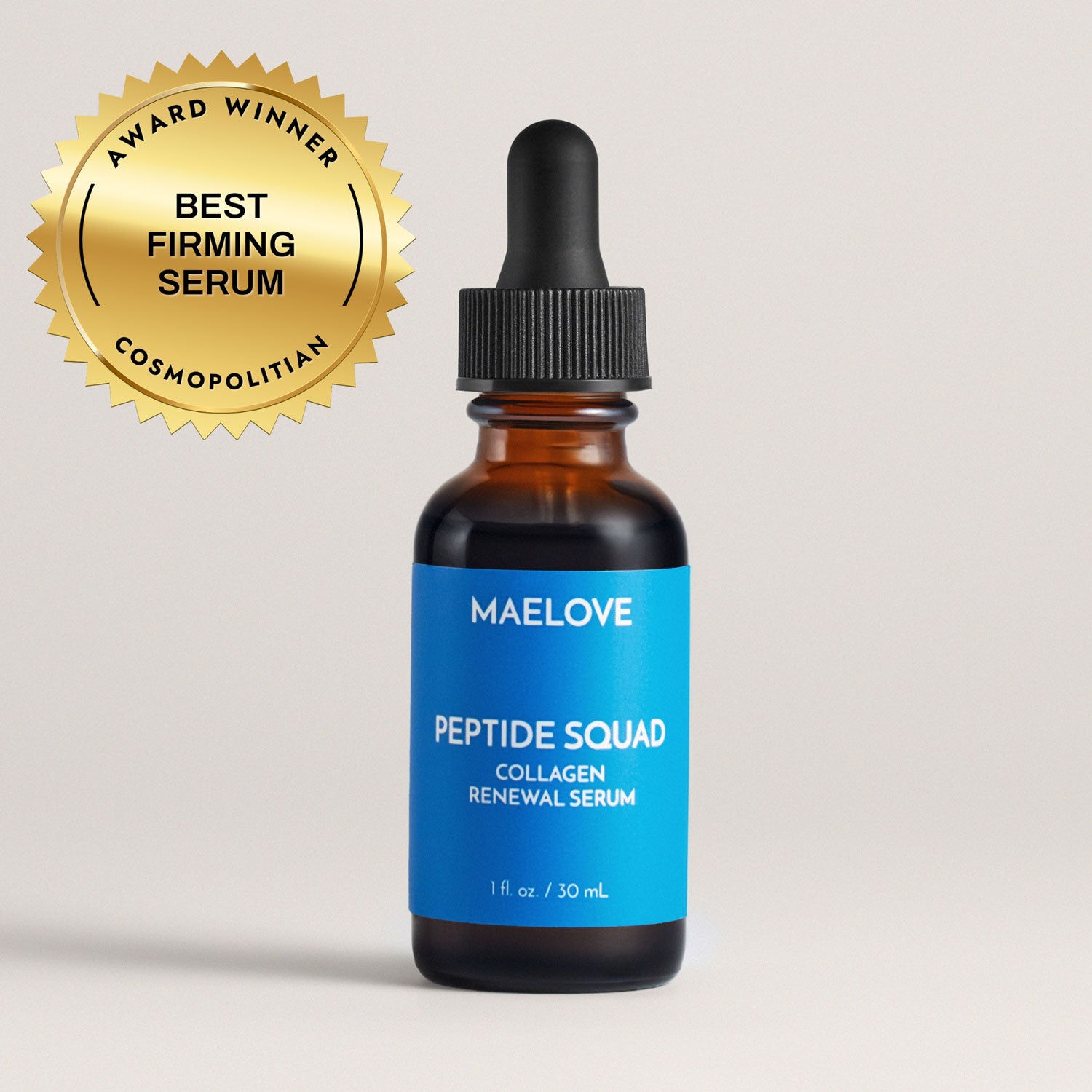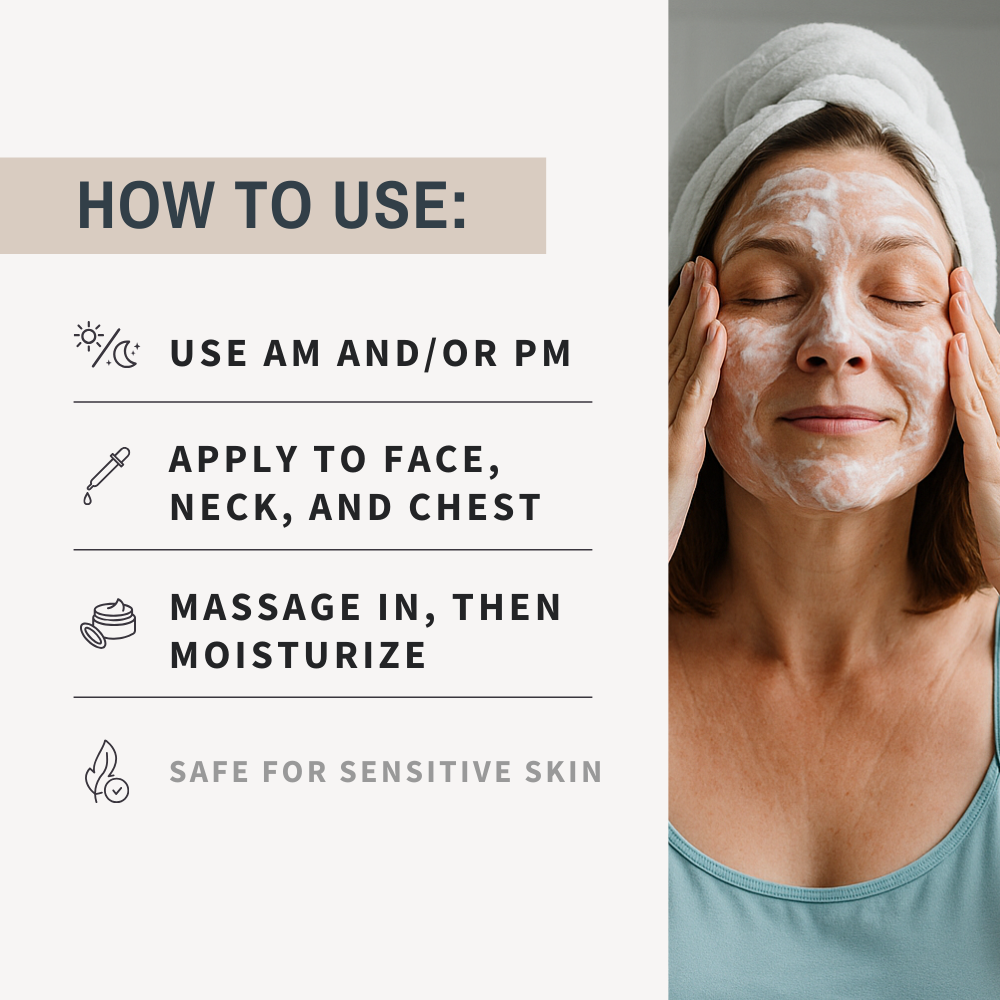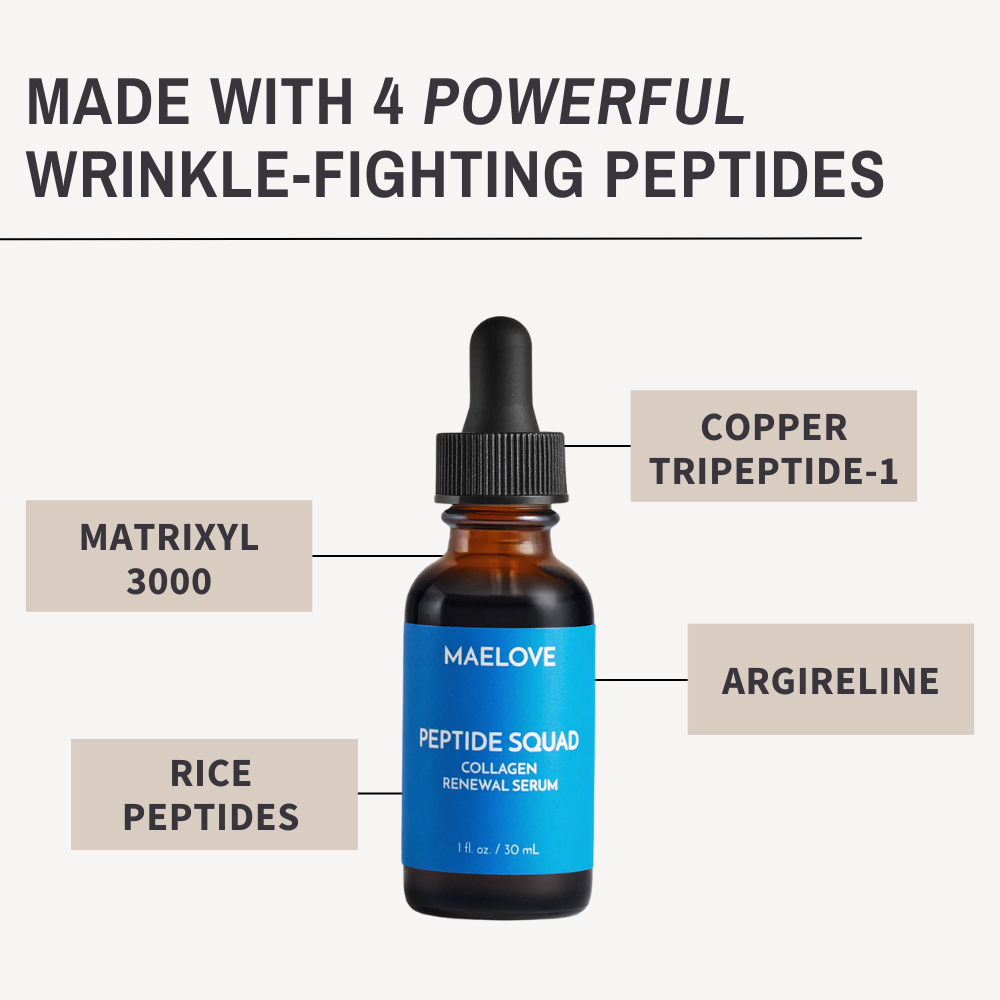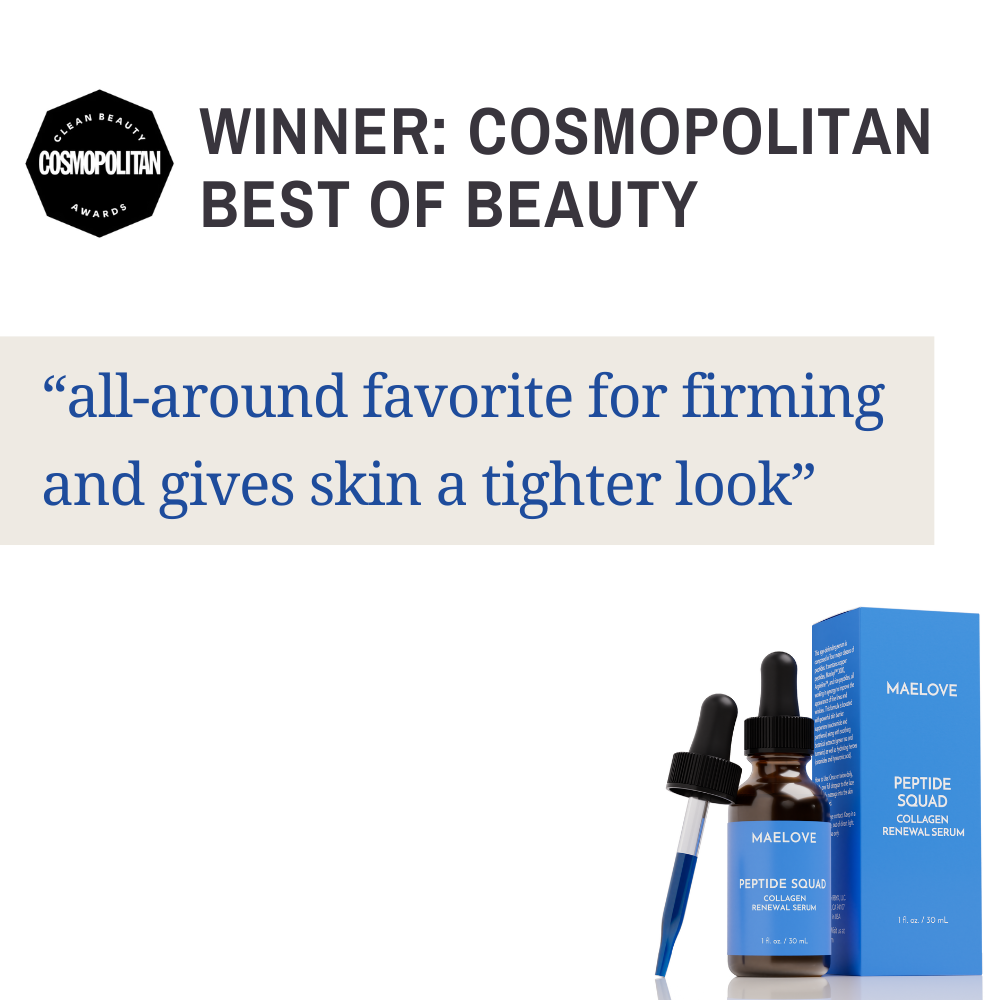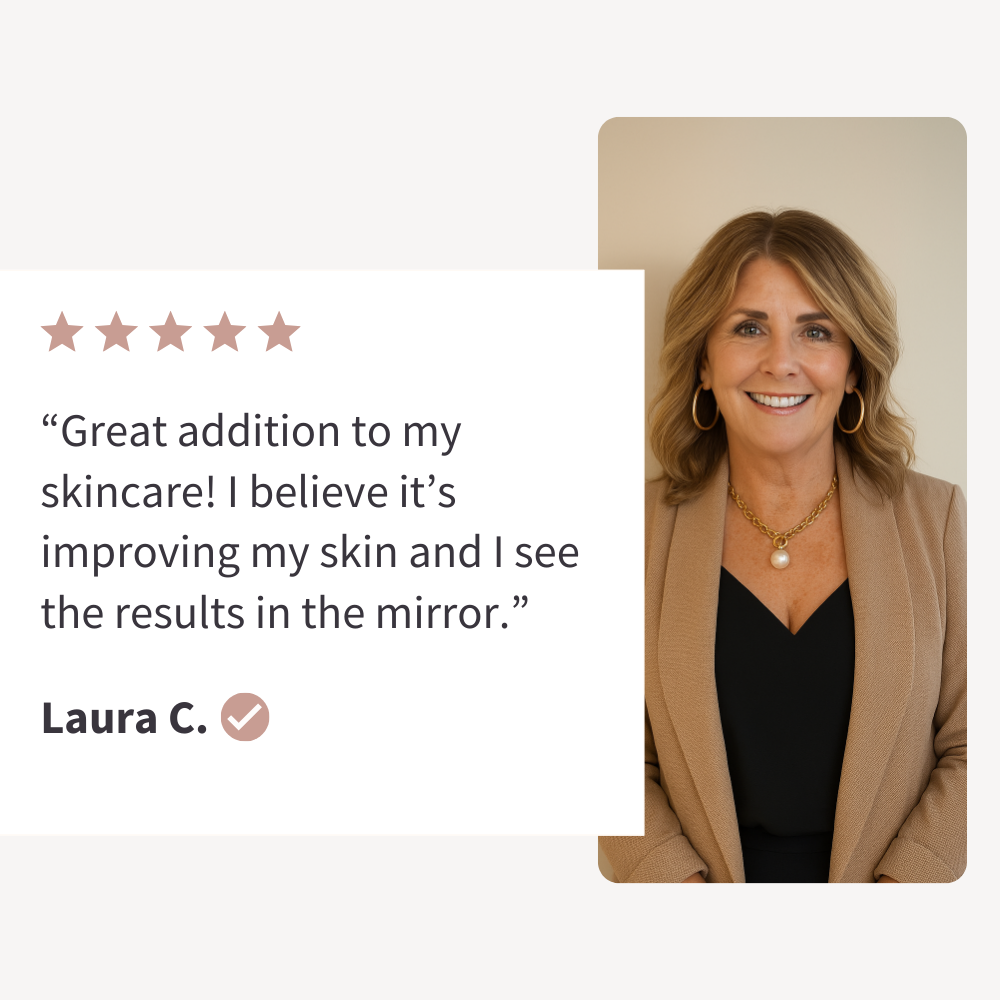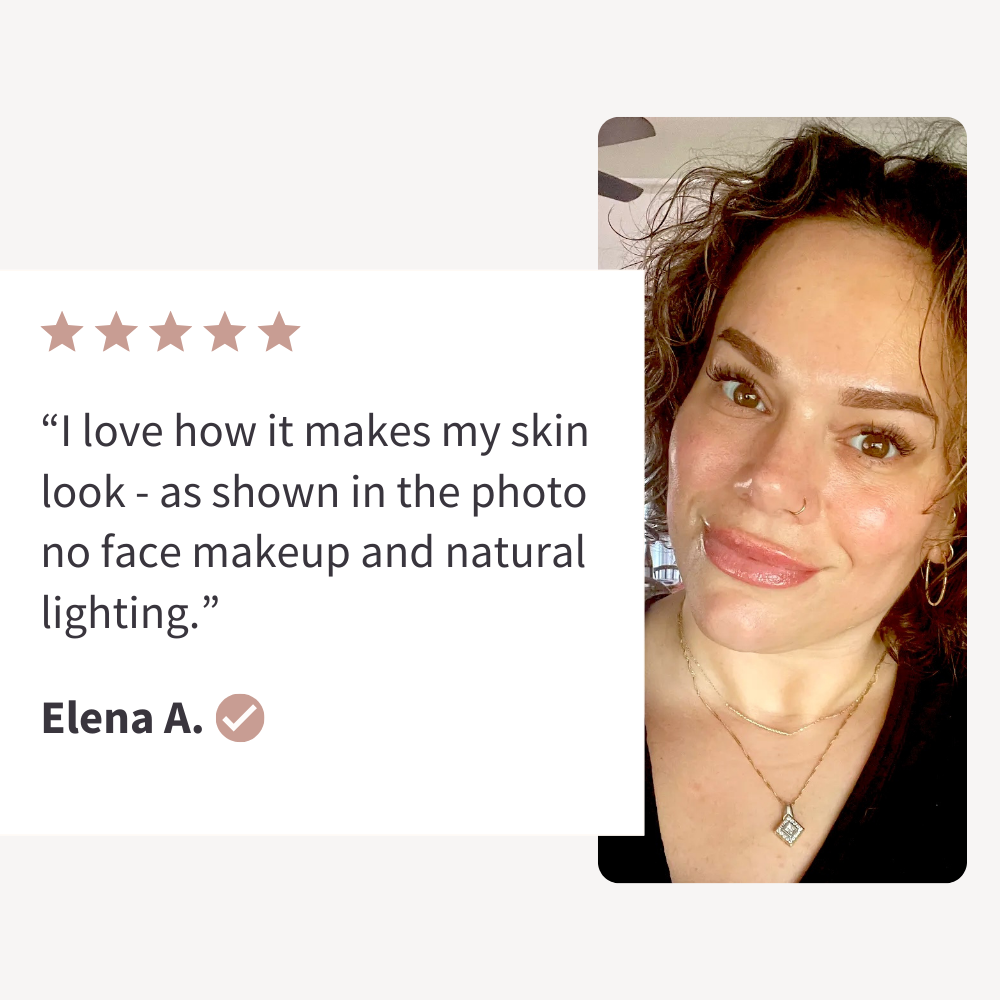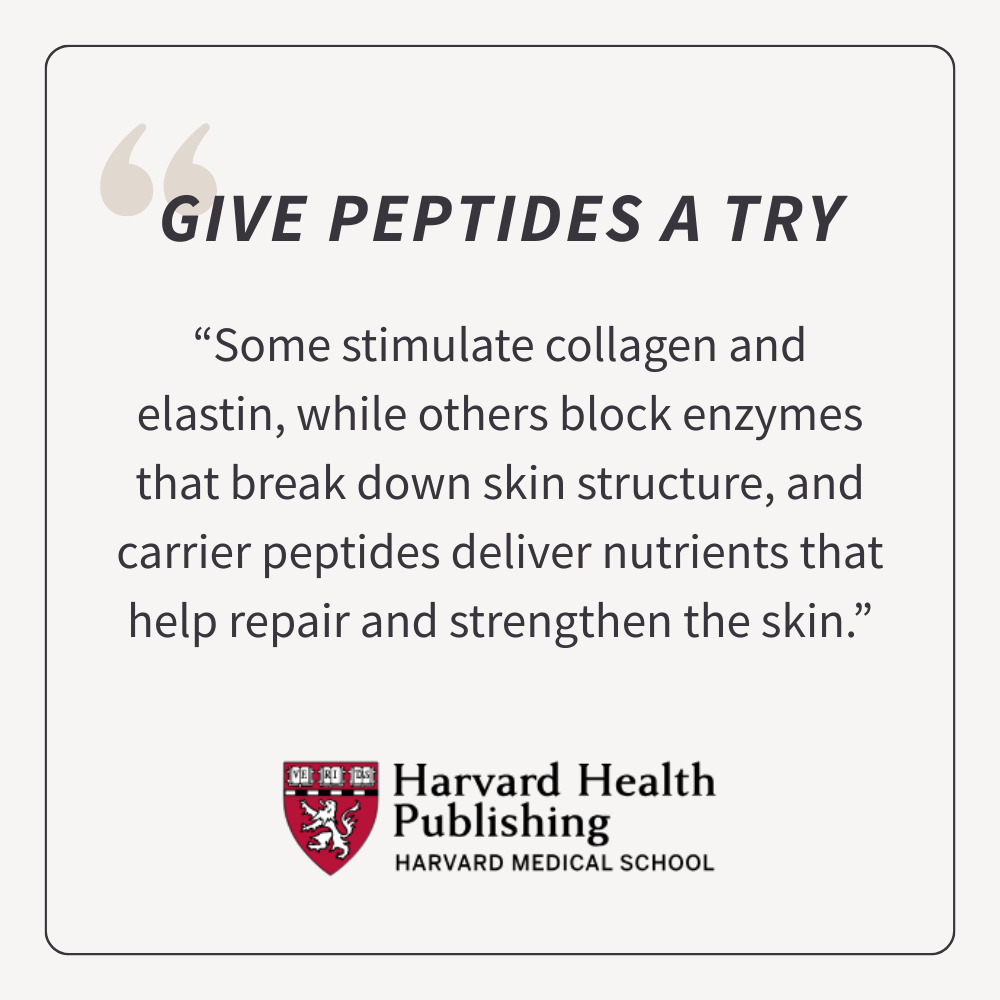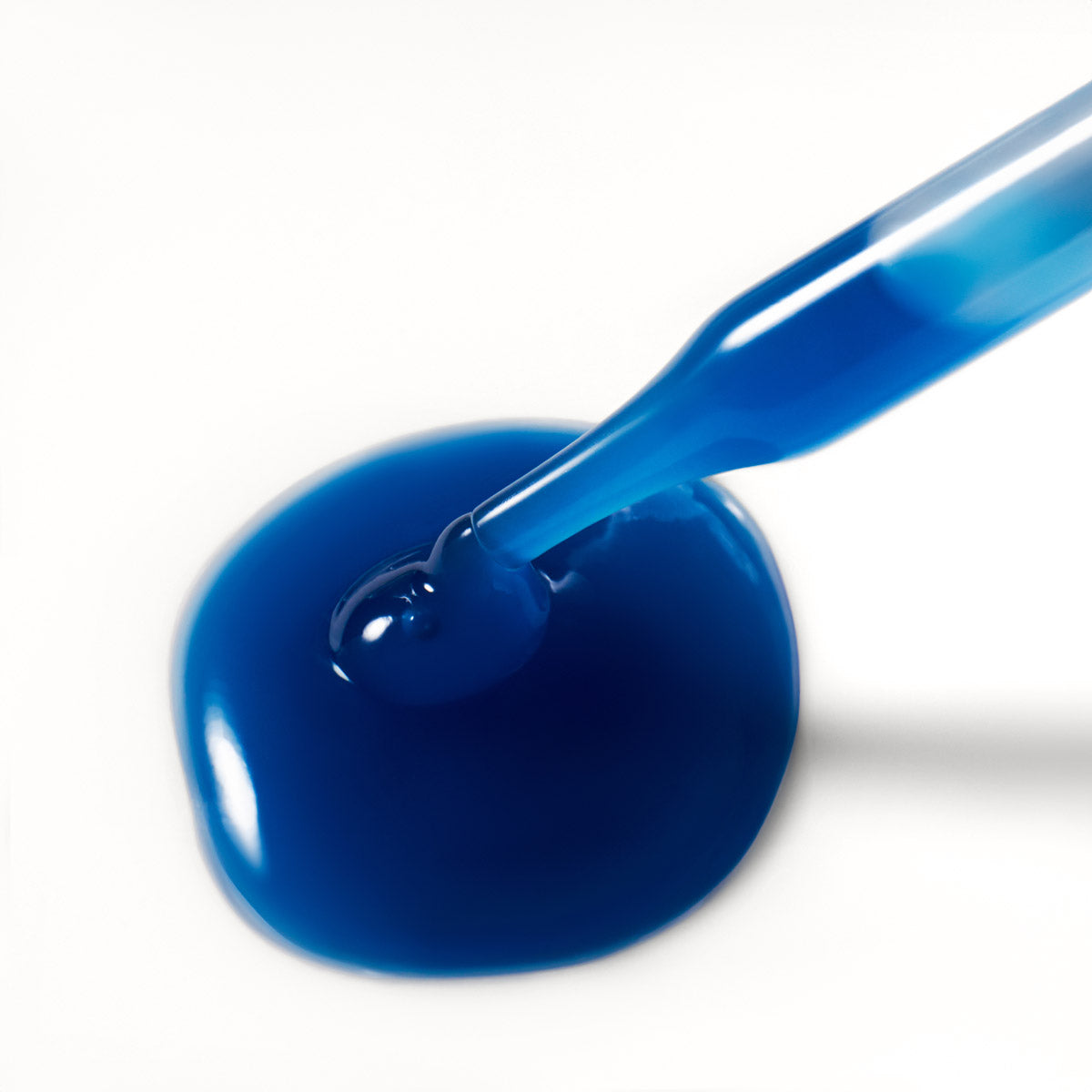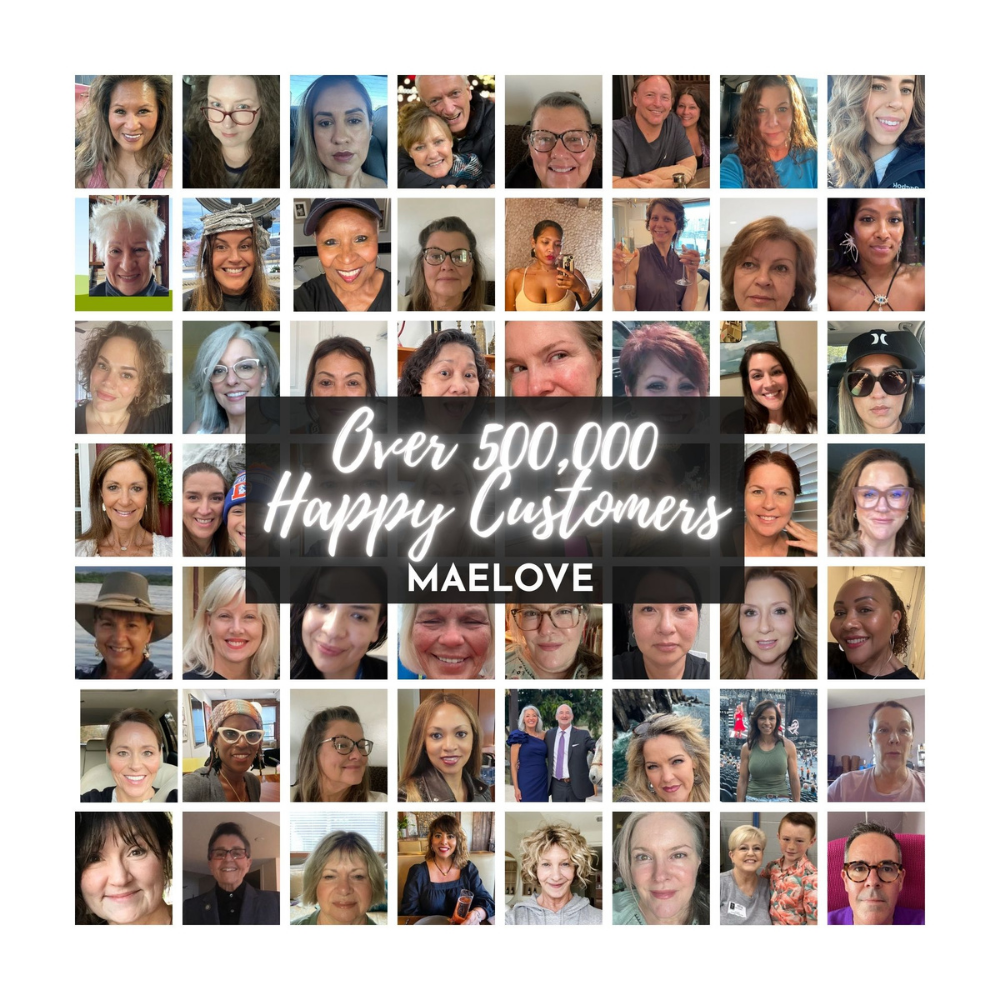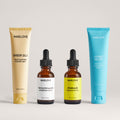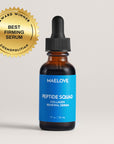
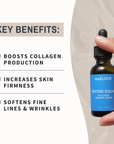
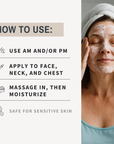
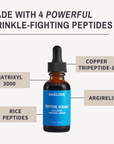
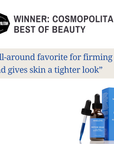
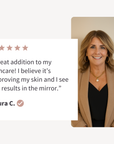

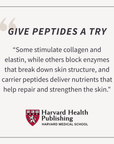
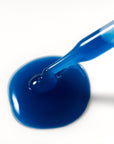

7300+ purchased in the last 30 days
Peptide Squad Collagen Renewal Serum
- Boosts collagen production
- Increases skin firmness
- Softens fine lines & wrinkles
- Copper tripeptide-1 (GHK-Cu)
- Matrixyl 3000
- Argireline
- Rice peptides
We firmly stand behind the efficacy of our products, which is why we back them with an industry-leading 100-day Money Back Guarantee.
If you're not 100% happy, return the products within 100 days for a full refund. We'll even cover the return shipping. It's our commitment to ensure that you're completely satisfied with your Maelove journey.
Introducing
Peptide Squad
Obsessively Formulated
Peptide Squad is meticulously formulated with all four types of science-backed peptides: Copper tripeptide (GHK-Cu) delivers vital copper for collagen synthesis, while Matrixyl 3000 stimulates collagen production. Argireline reduces expression lines, and rice peptides slow collagen breakdown.
We've boosted the naturally hydrating properties of peptides with a blend of hyaluronic acid, ceramides, and jojoba oil.
This naturally blue serum also contains skin-barrier-supporting niacinamide, panthenol and red algae help to fight redness, plus anti-inflammatory botanicals like allantoin, aloe, green tea, turmeric, madecassoside and bisabolol to further support the skin's barrier.
The only serum with all four categories of science-backed wrinkle-fighting peptides
- Copper peptides (GHK-Cu) are a carrier peptide that helps build collagen
- Argireline is a neurotransmitter-inhibiting peptide that relaxes facial muscles to reduce expression lines
- Matrixyl 3000 is a signal peptide that boosts collagen production for firmer skin
- Rice peptides are an enzyme-inhibitor peptide that prevents collagen breakdown
Balanced with a blend of nourishing, skin-barrier supporting ingredients
- Hydrating peptides, hyaluronic acid, jojoba oil, and ceramides provide deep hydration
- Niacinamide and panthenol offer anti-aging benefits while supporting the skin barrier
- Anti-inflammatory botanicals, polyphenols, and red algae calm and soothe redness
For AM and/or PM. Apply a thin layer of serum to the face, neck, and chest. Massage product in until it is fully absorbed. Follow with a gentle moisturizer to lock in the serum. You may experience a slight numbing or tingling sensation initially, which is normal.
Layer your products from thinnest to thickest in texture, waiting a full minute between each product. Peptide Squad can safely be used with any other Maelove product. (While all Maelove products are compatible for layering, we can’t speak for other brand’s products.)
See our How to Layer guide for tips on layering multiple Maelove products.
Key Ingredients
Peptides from all four classes of wrinkle-fighting peptides include signal peptides (Matrixyl 3000; Palmitoyl tripeptide-1 and palmitoyl tripeptide-7), neurotransmitter-inhibiting peptides (Argireline; Acetyl hexapeptide-8), carrier peptides (Copper Tripeptide-1), and enzyme inhibitor peptides (Rice peptides).
Supporting Ingredients
Skin barrier supporting, anti-inflammatory, and hydrating ingredients include Niacinamide, panthenol, hyaluronic acid, natural moisturizing factors, ceramides, jojoba oil, and botanical extracts and actives including allantoin, aloe, green tea, turmeric, red algae and polyphenols madecassoside (found in CICA) and bisabolol (found in chamomile).
All Maelove products are safe for sensitive skin, made in the US, vegan, cruelty-free, non-comedogenic, gluten-free, and free of parabens, phthalates, dyes, and artificial fragrances. We don't use ingredients that are banned in the EU or in the USA.
Show all ingredients
Customer Reviews
For The Curious
Peptides are generating quite a buzz in the skincare world these days, and for good reason! However, it’s crucial to understand that peptides are a diverse group of molecules, and not all of them are backed by solid scientific evidence.
It took us a year and a half of rigorous research and investigation to pinpoint the best peptides and perfect the formulation. What we discovered is game-changing: combining peptides with solid scientific backing from four distinct classes can genuinely improve the health and appearance of your skin. The beauty of Peptide Squad lies in its balanced formulation. By utilizing a full range of peptides, and co-formulating with the perfect supporting cast, we are able to deliver comprehensive skin benefits in a product that feels really great to apply.
The four classes include signal peptides (aka Matricin or Matrikine peptides), neurotransmitter inhibiting peptides, carrier peptides, and enzyme inhibiting peptides. Peptides are classified by the mechanisms by which they are known to fight wrinkles (Gorouhi and Maibach 2009, Ferreira et al. 2020, Schagen et al. 2017). By combining all four classes of peptides, this serum employs a multifactorial approach to fighting wrinkles and targeting the signs of aging from different angles. This approach can create synergies and leads to better results.
Signal peptides are also known as Matricin or Matrikine peptides and specifically refer to collagen or extracellular matrix (ECM) fragments which improve wrinkles and skin hydration by signaling fibroblasts to increase the production of collagen, elastin, glycosaminoglycans (GAGs) such as hyaluronic acid, and other components of the ECM including proteoglycans, fibronectin and laminin (Errante et al. 2020, Gorouhi and Maibach 2009).
Matrixyl 3000 is a patented combination of two signal peptides (pal-GHK and pal-GQPR, aka palmitoyl tripeptide-7 and palmitoyl tripeptide-1) which have known synergy with one another as first demonstrated in in-vitro studies with dermal fibroblasts (fibroblasts secrete collagen, elastin, and other ECM components in the dermal layer of the skin) (US patent 2004/0132667 A1). In these studies, the combination of pal-GHK and pal-GQPR was more effective at stimulating collagen type 1, fibronectin and hyaluronic acid than either peptide alone.
Subsequent placebo controlled clinical studies in both men and women showed that a cream containing Matrixyl 3000 significantly decreased wrinkle depth and volume as well as skin roughness. In the first clinical study in older women, Matrixyl 3000 cream was applied on half the face versus placebo on the other half for crow’s feet wrinkles. With Matrixyl 3000, they found a significant 23.3% decrease in wrinkle volume, a 19.9% decrease in wrinkle depth and 16% decrease in roughness compared to baseline but no benefit with placebo. In the second clinical study in older men, Matrixyl 3000 cream gel was applied on half the face versus placebo on the other half on crow’s feet wrinkles. With Matrixyl 3000, they found a significant 17.1% decrease in wrinkle volume and 10.2% decrease in wrinkle depth and 8.4% decrease in roughness compared to baseline but no benefit with placebo (Sederma Matrixyl 3000).
A final clinical study was conducted to image changes of the papillary dermis. As described in a follow-up US patent 2012/164488, Sederma conducted a double-blind, placebo-controlled clinical study in 28 women who applied Matrixyl 3000 on half the face and placebo on the other half for 2 months and found an improvement in dermal density and reduced fragmentation in the collagen fibers of the dermis with Matrixyl 3000 compared to placebo (Sederma Matrixyl 3000).
On their own, pal-GHK and pal-GQPR also represent two of the best studied signal peptides. As characteristic of signal peptides, GHK and GQPR are fragments of proteins found naturally in the human body that are involved in ECM remodeling particularly during wound healing. GHK is a fragment of the alpha 2 chain of type I collagen while GQPR is a fragment of immunoglobin G. By linking each of these peptides to a palmitoyl group (and hence the pal-), these peptides become lipophilic. In other words, being lipophilic, they can cross the stratum corneum, the waterproof outer layer of the skin barrier, and can be absorbed into the deeper layers of the skin where they have their action.
GHK was first isolated from human plasma in 1973 (Pickart and Thaler 1973) and its wound repair properties were first observed in 1985 by Maquart and colleagues who found GHK was a potent activator of ECM synthesis and remodeling (Maquart et al. 1999). GHK has been found since then to have multiple biological actions improving tissue repair in skin, lung connective tissue, boney tissue, liver, and stomach lining. It has a wide range of effects on gene expression (Pickart and Margolina 2018). When damage activates proteolytic enzymes, GHK is released into the site of injury. GHK can stimulate skin dermal fibroblasts to produce growth factors and increase collagen synthesis and epidermal basal cells increasing integrins and p63 expression (Pickart and Margolina 2018, Lintner 2002).
GHK content is highest in the young with plasma levels at about ~200ng/ml at age 20 which declines to ~80ng/ml at age 60. This natural decline with aging may in part explain why adding peptides back to the skin can reverse signs of aging. GHK has been used in anti-aging and cosmetic products in humans for decades without any adverse effects and so has an established safety record (Pickart and Margolina 2018). Even without co-formulation with pal-GQPR, pal-GHK can increase collagen and GAG synthesis as well as improve collagen repair (Sederma Matrixyl 3000).
There is some misinformation on the web that states signal peptides such as GHK that are involved in wound healing have negative effects such as increasing inflammation because they mimic wounds. This is untrue as GHK has proven anti-inflammatory and antioxidant activity. GHK has anti-inflammatory benefits by reducing TNF-alpha induced secretion of proinflammatory cytokine IL-6 in dermal fibroblasts, and GHK is an efficient antioxidant, inactivating damaging free radical by-products of lipid peroxidation (Pickart et al. 2015, Pickart and Margolina 2018).
Pal-GQPR has also been studied and used separately from pal-GHK for many years in both skin and eye creams. GQPR is a fragment of immunoglobin G which is immunomodulatory. As skin ages, there is an increase in inflammatory cytokine IL-6, which may contribute to chronic inflammation in the aging process. The putative mechanism by which Pal-GQPR works is by reducing IL-6 secretion by keratinocytes. However, like GHK, GQPR changes the expression of multiple genes and so it has a broad effect on fibroblast activity that goes beyond anti-inflammatory action. Studies by Sederma show that pal-GQPR and pal-GHK activate complementary genes explaining the synergy between the two peptides (Sederma Matrixyl 3000).
Neurotransmitter inhibiting peptides are sometimes informally called “botox-like” or a botox alternative, though this descriptor is disliked by dermatologists. Nonetheless, the principles behind these peptides are similar to that of botox in that they aim to act on the cholinergic neuromuscular junction to inhibit muscle activity and in this manner, limit wrinkle formation. For neurotransmitter acetylcholine to be released, a reaction cascade mediated by SNAP receptor proteins and SNARE complex formation is necessary. SNAP-25 specifically is targeted by both botulinum neurotoxin type A (botox) and the peptide included here, ArgirelineR. ArgirelineR competes with the SNARE complex by mimicking the N terminal end of SNAP-25 – hence preventing formation of the SNARE protein complex and inhibiting acetylcholine release and subsequent muscle contraction (Lipotec Argireline).
Argireline (also known as acetyl hexapeptide-8 or acetyl hexapeptide-3) has been shown to have an anti-wrinkle effect (Blanes-Mira et al. 2002, Draelos et al 2016). It has lower efficacy than botox itself but is a safe, non-toxic alternative (Blanes-Mira et al. 2002). Published clinical studies show its anti-wrinkle efficacy whether formulated alone (Blanes-Mira et al. 2002, Tadini et al. 2015) or in a mix of peptides (Draelos et al. 2016, Errante et al. 2020). Interestingly, a double-blind study using topical Argireline cream in patients receiving botox treatment for blepharospasm saw an extension of botox benefits to symptom control when using the cream, suggesting topical Argireline can also increase the length of botox benefits (Lungu et al. 2013). Clinical studies conducted by the manufacturer also demonstrate reduced eye wrinkle depth and volume with usage of Argireline creams (Lipotec Argireline).
Carrier peptides are believed to improve wrinkling and skin elasticity by delivering trace elements such as copper and manganese that can function as cofactors necessary for collagen and elastin production (Errante et al. 2020). In this class, the clear standout is Cu-GHK also known as copper tripeptide-1, which is by far the best studied and most established carrier peptide.
Dr. Loren Pickart in 1973 was the first to propose that signal peptide GHK could act as a carrier for copper, as GHK could complex with Cu(II) spontaneously. Cu-GHK is naturally released during wound healing to support healing after damage. Cu-GHK proposed function is as an activator of tissue remodeling. Specifically, it supports breakdown of scar tissue and promotes collagen synthesis, elastin, proteoglycan and GAG production as well as antioxidant and anti-inflammatory responses (Gorouhi and Maibach 2009).
Cu-GHK may serve as a natural built-in modulator of dermal repair. However, the levels decrease with age and youthful behavior of cells is restored when it is added back in. Serine proteases from bacteria can also break Cu-GHK down and so overwhelming these proteases with peptides can help overcome them. Further, Cu-GHK can cross the stratum corneum in sufficient quantities (Pickart et al. 2015).
Cu-GHK is a well-studied peptide including in vitro studies and several clinical trials with direct comparisons to control vehicles, other peptides, Vitamin C and retinoids. In in-vitro studies, even very small concentrations of Cu-GHK were found to stimulate increases in collagen and elastin and increase tissue inhibitors of metalloproteinases (TIMP) which inhibit collagen and elastin breakdown by metalloproteinases (MMPs) (Badenhorst et al. 2016). Furthermore, in a clinical study, application of a cream with GHK-Cu significantly reduced wrinkle volume by 55.8% more than a vehicle alone after 8 weeks in 40-65 yo women (Badenhorst et al. 2016).
In a head-to-head comparison study with tretinoin, Vitamin C, melatonin, and Cu-GHK though no significant differences were found due to only ten subjects being enrolled, increased pro-collagen synthesis was found for 4/10, 5/10, 5/10, and 7/10 of patients respectively suggesting more patients responded to Cu-GHK than other collagen increasing compounds (Abdulghani et al 1998). In another double-blind comparison with 0.075% retinol, compatible improvements were found in wrinkling and overall photodamage with Cu-GHK cream, and significantly greater improvements for both compared to placebo (Leydon et al. 2002).
Enzyme inhibitor peptides directly or indirectly suppress enzymes that breakdown collagen, elastin, GAGs and other ECM components, and specifically, inhibit matrix metalloproteinases (MMPs). These include rice and soybean peptides which can inhibit serine proteases such as MMPs (Schagen 2017, Ferreira 2020). Rice peptides inhibit MMP activity and stimulate hyaluronan synthase (hyaluronic acid is a GAG) as well as having anti-tyrosinase activity for hyperpigmentation (Schagen 2017). Rice oligos with Vitamin C in ampoules have also been tested in humans with positive findings (Escobar et al. 2020). The added benefit of rice peptides is that they are natural humectants that can help keep skin hydrated (Purnawati et al. 2017).
Other supporting ingredients in Peptide Squad include antioxidants, anti-inflammatories and hydrating ingredients, and skin barrier supporting ingredients. Antioxidants from botanical extract such as green tea, aloe, turmeric, as well as madecassoside which is an active found in Centella Asiatica can help to suppress MMPs and help the collagen-building peptides perform more optimally. Free radicals are the driving force behind the increased levels of MMPs in aged skin and antioxidants are the key protective mechanisms against these free radicals (Shin et al. 2019).
Anti-inflammatories which include niacinamide, panthenol, allantoin, red algae, and bisabolol which is an active found in german chamomile, make this serum a soothing serum that helps fight inflammation and redness. Along with hydrating ingredients that help fill in cracks in skin barrier such as ceramides, jojoba oil and humectants such as hyaluronic acid, panthenol, and natural moisturizing factors, this highly hydrating serum can also address the dry, cracked, red, and inflamed skin that often accompanies the aging process for an all-in-one solution. Finally, niacinamide and panthenol are known to support the long-term increased production of lipids and proteins that support the skin barrier. They complement the long-term action of the wrinkle-fighting peptides. Together, this serum not only helps in the fight against fine lines and wrinkles, but also helps with the more immediate problems of aging skin such as skin dryness, skin inflammation, and a damaged skin barrier.
Hydrating and soothing ingredients allows this serum to have instant benefits to skin dryness and inflammation. And with two months of consistent and daily usage, you should start to also see visible improvements in the appearance of fine lines and wrinkles as well as a more bouncy and youthful complexion.
Yes! The concern with using peptides and vitamin C or retinols is due to free copper ions, which can be reactive. The form of copper contained in Peptide Squad is bound to copper tripeptide-1, which is a stable compound that naturally occurs in skin. Additional tests conducted confirm a lack of reactivity between Peptide Squad and Glow Maker vitamin C serum.
Free copper (Cu2+) unbound to GHK can interact with ascorbic acid (vitamin C) (Chiou 1983). This interaction is greatly diminished by the addition of metal chelators suggesting free copper is necessary for this reaction with ascorbic acid (Chiou et al. 1985). GHK acts as a copper chelator by binding copper tightly (Freedman et al. 1982). GHK complexes with Cu2+ spontaneously and simplifies absorption (Errante 2020). Indeed, conjugated copper in the form of GHK-Cu, unlike free copper or other copper compounds, does not stimulate an inflammatory action nor cytotoxity in keratinocytes and functions as an ideal carrier for copper to be utilized as a cofactor inside cells (Li et al. 2016). Hence, GHK-Cu is unique amongst the copper peptides. GHK-Cu is naturally found in the skin along with vitamin C as both are necessary for the formation of collagen. Finally, our internal tests show Peptide Squad doesn't lead to oxidation of vitamin C in the Glow Maker serum - as would be expected if free copper was catalyzing the oxidation of vitamin C.
Encapsulation is a technique used in skincare and may be used for many reasons, including protection of a reactive or unstable ingredient from degradation or reacting with other ingredients. Peptides are generally not reactive nor unstable. However, some may opt to use encapsulated copper peptides in the belief that this protects the potential free copper which is a pro-oxidant from interactions with Vitamin C which is an antioxidant.
We do not advise our customers to use encapsulated copper peptides at this time, mainly because the available encapsulated copper peptides on the market are not the tried and true Cu-GHK but rather, Copper Palmitoyl Heptapeptide-14. There are no published scientific reports on this ingredient outside of the supplier. In other words, the encapsulated version may no longer have all of the skin beneficial effects long described in scientific literature for Cu-GHK. Further, if this ingredient results in free copper, then encapsulating that free copper would allow it to penetrate into the skin and oxidize the lipids and proteins in the skin which is damaging.
Not all copper is good copper. With the wrong carrier, copper can cause both damage to cells and inflammation (Li et al. 2016, Pickart et al. 2015). In your skin, the safe delivery of copper is trusted to GHK-Cu. GHK-Cu is like riding with a chauffeur you have trusted all the years of your life. Whereas, other copper peptides are like hitch-hiking a ride with a stranger. The risk isn’t worth it.
We believe the secret to a good copper peptide serum is to make sure it has no free copper ions, not to encapsulate these potential free copper ions so that they can be delivered inside your skin to wreak extra havoc.
Our advice: stick with the tried and true Cu-GHK
Yes. The actives in Peptide Squad including peptides, niacinamide, panthenol, hyaluronic acid, natural moisturizing factors, ceramides and jojoba and botanical extracts and actives including allantoin, aloe, green tea, turmeric and polyphenols such as madecassoside (found in CICA) and bisabolol (found in chamomile) are all considered generally safe to use topically during pregnancy and lactation.
However, it is always advisable to check with your doctor regarding skin care products and ingredients and follow their protocol.
Ferreira MS, Magalhaes MC, Sousa-Lobo JM, Almeida IF (2020). “Trending Anti-Aging Peptides.” Cosmetics 7: 91. Doi:10.3390/cosmetics7040091
Gorouhi F and Maibach HI (2009). “Role of topical peptides in preventing or treating aged skin.” Int J Cosmetic Sci. 31: 327-345.
Schagen SK (2017). “Topical Peptide Treatments with Effective Anti-Aging Results.” Cosmetics 4:16. Doi:10.3390/cosmetics4020016.
Errante F, Ledwon P, Latajka R, Rovero P, Papini AM (2020). “Cosmeceutical Peptides in the Framework of Sustainable Wellness Economy.” Frontiers in Chemistry 8: 572923. Doi: 10.3389/fchem.2020.572923.
Gorouhi F and Maibach HI (2009). “Role of topical peptides in preventing or treating aged skin.” Int J Cosmetic Sci. 31: 327-345.
Lintner K (2002). “Promoting production in the extracellular matrix without compromising barrier.” Cutis 70(6Suppl): 13–16.
Maquart FX, Siméon A, Pasco S, Monboisse JC (1999). “Regulation of cell activity by the extracellular matrix: the concept of matrikines.” J Soc Biol 193: 423–428.
Pickart L, Thaler MM (1973). “Tripeptide in human serum which prolongs survival of normal liver cells and stimulates growth in neoplastic liver.” Nat New Biol 243: 85–87.
Pickart L, Vasquez-Soltero JM, Margolina A (2015). “GHK Peptide as a Natural Modulator of Multiple Cellular Pathways in Skin Regeneration.” BioMed Research International 648108. http://dx.doi.org/10.1155/2015/648108.
Pickart L, Margolina A (2018). “Regenerative and Protective Actions of the GHK-Cu Peptide in the Light of the New Gene Data.” Int J Mol Sci 19. Doi:10.3390/ijms19071987.
Sederma, Matrixyl 3000 fact sheet. https://eyzhnelen.gr/wp-content/uploads/2018/05/ProductInformationFile_MATRIXYL-3000.pdf
US patent 2004/0132667 A1. Lintner K (2005). “Compositions containing mixtures of tetrapeptides and tripeptides.” https://patentscope.wipo.int/search/en/detail.jsf?docId=WO2005048968
US Patent 2012/164488. Fournial A, Mondon P (2012). “New Cosmetic or Dermopharmaceutical Topical Use of a Mixture of a Ghk Tripeptide and Gqpr Tetrapeptide.” https://patents.google.com/patent/WO2012164488A2/en
Blanes-Mira C, Clemente J, Jodas G, Gil A, Fernandez-Ballester G, Ponsati B, Gutierrez L, Perez-Paya E, Ferrer-Montiel A (2002). “A synthetic hexapeptide (Argireline) with antiwrinkle activity.” Int J Cosmet Sci 24(5): 303-310.
Draelos ZD, Kononov T, Fox T (2016). “An Open Label Clinical Trial of a Peptide Treatment Serum and Supporting Regimen Designed to Improve the Appearance of Aging Facial Skin.” J Drugs Dermatol 15(9): 1100-1106.
Errante F, Ledwon P, Latajka R, Rovero P, Papini AM (2020). “Cosmeceutical Peptides in the Framework of Sustainable Wellness Economy.” Frontiers in Chemistry 8: 572923. Doi: 10.3389/fchem.2020.572923.
Lipotec Argireline. https://www.lubrizol.com/Personal-Care/Products/Product-Finder/Products-Data/Argireline-Amplified-peptide-solution
Lungu C, Considine E, Zahir S, Ponsati B, Arrastia S, Hallett M (2013). “Pilot Study of Topical Acetyl Hexapeptide-8 in Treatment of Blepharospasm in Patients Receiving Botulinum Neurotoxin Therapy.” Eur J Neurol. 20(3): 515-518.
Tadini KA, Mercurio DG, Campo PMBGM (2015). “Acetyl hexapeptide-3 in a cosmetic formulation acts on skin mechanical properties – clinical study.” Brazilian J Pharmaceutic Sci 51(4): 901-909. Doi.org/10.1590/S1984-82502015000400016.
Abdulghani AA, Sherr A, Shirin S, Solodkina G, Tapia EM, Wolf B, Gottlieb AB Abdulghani J, Sherr V (1998). “Effects of topical creams containing vitamin C, a copper-binding peptide cream and melatonin compared with tretinoin on the ultrastructure of normal skin – A pilot clinical, histologic, and ultrastructural study.” Dis Manag Clin Out 1(4): 136-141
Badenhorst T, Svirskis D, Merrilees M, Bolke L, Wu Z (2016). “Effects of GHK-Cu on MMP and TIMP Expression, Collagen and Elastin Production, and Facial Wrinkle Parameters.” J Aging Sci 4: 166. Doi:10.4172/2329-8847.1000166.
Errante F, Ledwon P, Latajka R, Rovero P, Papini AM (2020). “Cosmeceutical Peptides in the Framework of Sustainable Wellness Economy.” Frontiers in Chemistry 8: 572923. Doi: 10.3389/fchem.2020.572923.
Gorouhi F and Maibach HI (2009). “Role of topical peptides in preventing or treating aged skin.” Int J Cosmetic Sci. 31: 327-345.
Leyden JJ, Grove G, Stephens TJ, Finkey MB, Barkovic S, Appa Y (2002). “Skin benefits of copper peptide containing facial cream.” American Academy of Dermatology 60th Annual Meeting, February 22-27, New Orleans, LA.
Pickart L, Vasquez-Soltero JM, Margolina A (2015). “GHK-Cu may prevent oxidative stress in skin by regulating copper and modifying expression of numerous antioxidant genes.” Cosmetics 2: 236-246. Doi:10.3390/cosmetics2030236.
Escobar S, Valois A, Nielsen M, Closs B, Kerob D (2021). “Effectiveness of a formulation containing peptides and vitamin C in treating signs of facial ageing: three clinical studies.” Int J Cosmetic Sci 43: 131-135.
Ferreira MS, Magalhaes MC, Sousa-Lobo JM, Almeida IF (2020). “Trending Anti-Aging Peptides.” Cosmetics 7: 91. Doi:10.3390/cosmetics7040091
Purnamawati S, Indrastuti N, Danarti R, Saefudin T (2017). “The Role of Moisturizers in Addressing Various Kinds of Dermatitis: A Review.” Clinical Medicine and Research 15(3-4): 75-87.
Schagen SK (2017). “Topical Peptide Treatments with Effective Anti-Aging Results.” Cosmetics 4:16. Doi:10.3390/cosmetics4020016.
Shin JW, Kwon SH, Choi JY, Na JI, Huh CH, Choi HR, Park KC (2019). “Molecular Mechanisms of Dermal Aging and Antiaging Approaches.” Int J Mol Sci 20: 2126. Doi: 10.3390/ijms20092126.
Chiou SH (1983). “DNA- and protein-scisson activities of ascorbate in the presence of copper ion and a copper-peptide complex.” J Biochem 94(4): 1259-1267.
Chiou SH, Chang WC, Jou YS, Chung HM, Lo TB (1985). “Specific Cleavages of DNA by Ascorbate in the Presence of Copper Ion or Copper Chelates.” J Biochem 98(6): 1723-1726.
Errante F, Ledwon P, Latajka R, Rovero P, Papini AM (2020). “Cosmeceutical Peptides in the Framework of Sustainable Wellness Economy.” Frontiers in Chemistry 8: 572923. Doi: 10.3389/fchem.2020.572923.
Li H, Toh PZ, Tan JY, Zin MT Lee CY, Li B, Leolukman M, Bao H, Kang L (2016). “Selected Biomarkers Revealed Potential Skin Toxicity Caused by Certain Copper Compounds.” Scientific Reports 6: 37664. Doi:10.1038/srep37664.

Peptides are the new buzzwords on the face of numerous serums, each claiming transformative benefits. How do you decide if they will do something for you? For those of you...
